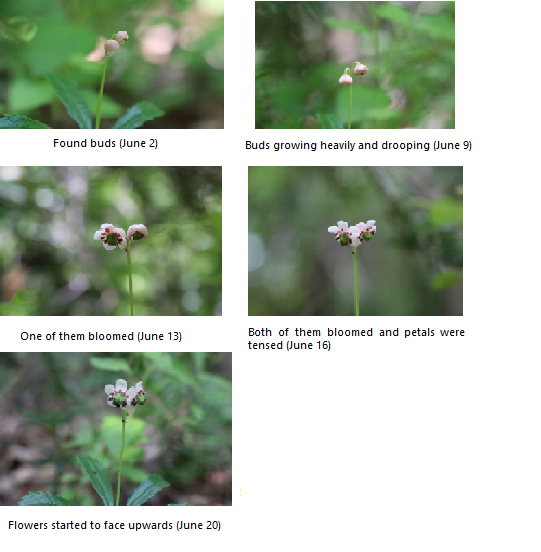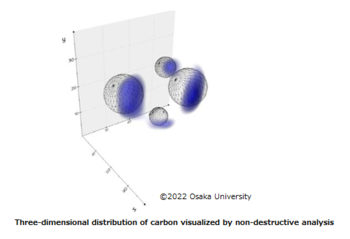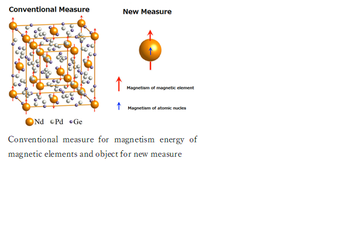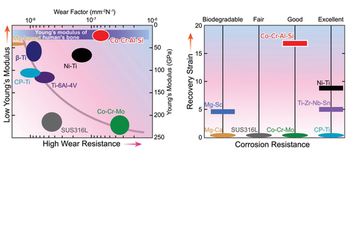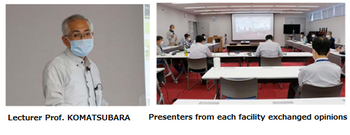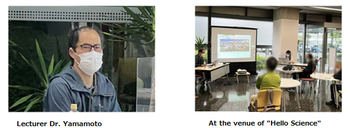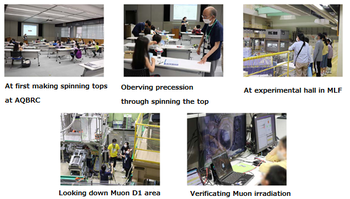J-PARC News June 2022 (Issue #206)
■Successful Nondestructive Three-Dimensional Element Analysis Using Muon Elementary Particles
—Development of New Technology by Combining Quantum Beam Technology and Space Observation Detectors— (April 26)
A research group from the Radioisotope Research Center of Osaka University, the University of Tokyo, and KEK have succeeded in visualizing the three-dimensional element distribution of a material nondestructively, for the first time in the world, by using the world's highest intensity pulsed muon beam available in the Muon Science Establishment (MUSE) at J-PARC. In this research, a two-dimensional projection of the element distribution, specifying carbon, was obtained by combining a nondestructive element analysis method using muons together with imaging detectors developed for space observation. By applying technology for image reconstruction used in medical diagnosis, consequently, it became possible to elucidate the three-dimensional element distribution. Moreover, this technology also enables the measurement of light elements and analysis of precious samples that cannot be destroyed, such as cultural properties or medicines in bottles. A broad range of applications beyond basic research can be expected.
For more information, please visit the J-PARC website.
https://j-parc.jp/c/press-release/2022/04/26000931.html
■ Measurement of the Magnetism of Small Atoms by Comparing with the Magnetism of Even Smaller Atomic Nuclei
—Development of a New, Simple, and Accurate Method of Measuring the Magnetism of Atoms, Useful for Developing Powerful Magnets— (May 15)
A research team from JAEA and other institutions has developed a new technique for measuring the magnetic moment of magnetic materials. The signal from the magnetic element is obtained by the interference of the scattering from the ordered moment with the nuclear spin polarized by the on-site hyperfine field at very low temperatures. The nuclear polarization has been confirmed by measuring the hyperfine spectra of the magnetic atom using the Biomolecular Dynamics Spectrometer (DNA) at J-PARC's Materials and Life Science Experimental Facility (MLF). Accordingly, this method shows promise for future use in areas such as the development of new materials used in powerful magnets.
For more information, please visit the J-PARC website.
https://j-parc.jp/c/press-release/2022/05/15000945.html
■ Flexible and Strong! Development of Metallic Materials with Properties Similar to Human Bone
- Expectations for Application to Bone Plates and Artificial Joints - (May 19)
With the progression to a super-aging society, the demand for implants for the treatment of bone and joint diseases is increasing, requiring the development of superior biomaterials. A research group from Tohoku University Graduate School, Institute for Materials Research, Tohoku University, and JAEA has developed a new Co-Cr-Al-Si alloy consisting mainly of cobalt and chromium, with aluminum and silicon added. Conventionally, it has been difficult to develop biomaterials having both a low Young's modulus (flexibility) and wear resistance (toughness); but this new alloy has a high wear resistance comparable to the existing CoCr alloys, while at the same time achieving an extremely low Young's modulus close to that of the human bone. Moreover, the alloy also exhibited a fatigue life of more than 10 million cycles for deformations as large as 1.65% and maintained a low Young's modulus. This is the first realization of a biomaterial with four key characteristics: low Young's modulus, high corrosion resistance, high abrasion resistance, and excellent superelastic properties, which may be applied to artificial joints, bone plates, dental implants, and spinal cord fixation devices.
For more information, please visit the J-PARC website.
https://j-parc.jp/c/press-release/2022/05/19000958.html
■J-PARC Safety Day (May 23)
“J-PARC Safety Day” is held every year around May 23, which is the important day when the radioactive material leak incident occurred in 2013, in order not to forget the lessons learned from and to strengthen the safety at J-PARC. This year 350 staff attended a remote live.
Following the ceremony to commend prizes for safety contributions and awards for good practices, a lecture titled “Improvement of ability to implement on-site safety through manuals: Safety Ergonomics Approach” was given by Prof. Akinori KOMATSUBARA of the Faculty of Science and Engineering, Waseda University. In the lecture, he said that three factors cause not to follow the rules and manuals: “lack of knowledge,” “lack of skills” and “lack of motivation.” He also said that these are caused by various reasons, such as too many tasks for workers’ skills or workforce, cognitive bias, and the tendency that workers come not to think for themselves due to detailed manuals. He introduced reviewed the work processes, and customs to reconsider what they did and understand the principles behind manuals as specific measures to be taken. Finally, as a new attempt, activities to implement safety at the Accelerator Facilities, Materials and Life Science Experimental Facility (MLF), Hadron Experimental Facility, and Neutrino Experimental Facility were introduced and discussed by them all the attendees.
■J-PARC Hello Science “Acceleration of High Intensity Proton Beam with Saving Energy” (May 27)
Hello Science in May was held at AYA'S LABORATORY Quantum Beam Research Center (AQBRC), with a face-to-face and online lecture given by Dr. YAMAMOTO Masanobu of the Accelerator Division of J-PARC. Accelerators of J-PARC consist of various equipment and use a large amount of electricity for accelerating beams. The 3-GeV synchrotron accelerator, of which Dr. Yamamoto is in charge, contributes to accelerating protons from 400 million electron volts to 3 billion electron volts. Radiofrequency accelerating cavities consume 12-MW, which is half of the 24-MW needed for generating a 1-MW beam with a 3-GeV synchrotron accelerator. When the beam intensity increases higher, more precise experiments will be feasible and more devotion to society will be possible. However, more electricity is needed than the current amount of it for that. Moreover, the enhancement of electrical power sources requires the use of cooling equipment, and receiving electricity equipment requires a huge amount of cost and time for infrastructure development.
Then Dr. Yamamoto tried to improve the structure of radio frequency accelerating cavities. While he continued to try to error for electrical power saving, he found that the exchange of all 12-accelerating cavities to single-ended type to reduce the beam load power made it possible to drastically save the amount of electricity. Because of seeking measurements to accelerate for over 1-MW beams, he could find an unexpected method to substantially reduce the amount of electricity by using 1-MW beams. He said that it was important for us to try various ways not to stick to stereotypes.
■"Spark Exciting Science" sponsored by KAKENHI entitled "The World of Cutting-Edge Physics understood through the world's smallest spinning top" was held (June 18)
Nineteen 5th or 6th grader students from local elementary schools, ones in nearby prefectures and Tokyo took part in this event and engaged in practice for Muon beams after learning elementary particle Muon.
When humans observe objects surrounding us from a microviewpoint, we finally reach the elementary particles. One sort of this is the muon. Muons, which we have at the MLF of J-PARC, have electrical charges and a character like a spinning top. The kids learned Muons have the features of magnets through experiments to visualize a magnetic field made by magnets and coils and to observe the precession movement of a rolling gyroscope and a handmade spinning top.
After that, they created cloud chambers to catch radiation, muon, α-ray, β-ray, and γ-ray and observed them. Moreover, they learned an overview of J-PARC, went to the Muon Science Laboratory, and experienced the irradiation of muon beams into a sample. Monumentally, they are the first elementary school students to participate in an experiment with muon beams at MLF. We're expecting that the attendees will be intrigued by elementary particles and, consequently, they will research with J-PARC staff in the future.
This event is a part of the ‘Spark ☆ Exciting Science Workshop sponsored by KAKENHI’, which is a program for kids to get excited about the cutting-edge research findings conducted by universities and research institutions financially supported by KAKENHI through directly looking, listening, and touching.
■Information about J-PARC Online Open House in 2022 (August 27)
It was decided that the J-PARC Online Open House will be held online this year as well. We will keep you updated on the details in the next issue.
■A Step Toward Higher Performance Lithium-Ion Batteries
—Successful Elucidation of the SEI Coating Formation Mechanism in Anodes—
A group led by Dr. Hiroyuki KAWAURA, Senior Researcher of the Toyota Central R&D Labs, working jointly with Associate Professor Norifumi YAMADA of the High Energy Accelerator Research Organization (KEK) and a member of the Neutron Science Section, has used the SOFIA neutron reflectometer at the MLF to ascertain the formation mechanism of solid electrolyte interphase (SEI) layers, which formed at the interface of the anode and electrolyte in the charging/discharging operation of lithium-ion batteries. The research group nondestructively observed the Li intercalation/deintercalation and the formation process of the SEI layer on the electrode during charging/discharging using a neutron beam with high penetrating power that can detect light elements such as Li, C, and O. The effects of electrolyte composition on changes in SEI layer structure were also elucidated using analysis employing hard X-ray photoelectron spectroscopy. The performance of lithium batteries varies greatly depending on the SEI layer, and thus these results are expected to contribute to higher battery performance, such as charge/discharge cycle characteristics.
These research results were featured in the Bulletin of the Chemical Society of Japan and ACS Appl. Mater. Interfaces of the American Chemical Society.
Bull. Chem. Soc. Jpn. 2020, 93, 854–861
https://doi.org/10.1246/bcsj.20200044
ACS Appl. Mater. Interfaces 2022, 14, 21, 24526–24535
https://doi.org/10.1021/acsami.2c06471
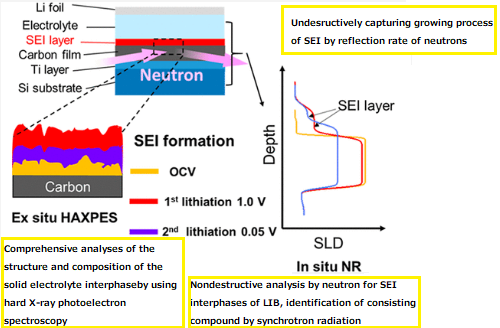
■Sanpo-michi #24: — Flowers of Prince’s Pine Successfully Observed This Year —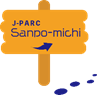
We’d like to bring the information about Prince’s Pine brought via this column last year. This year, there was a blossom observed in which only two flowers from one stem bloomed.
Plant strains of Prince’s Pine are connected to rhizomes, so leaves appear here and there in the growing area of JAEA’s site. We carefully walked not to stamp on this endangered species designated by Ibaraki Prefecture and we put the camera toward them. Comparison of these flowers in our hands, feet, and camera makes us realize how tiny they are.
Probably the Japanese name of this plant, “Oh-ume-Gasa-sou,” comes from those petals similar to plums blooming downwards like an umbrella. However, petals facing downwards at the beginning of the bloom start to face upward day by day.
This year the rainy season began on June 6th in the Kanto region. Prince’s Pine coexists with bacteria living around the pines’ roots. Rainwater had fallen so far into the branches and leaves and big raindrops. And they relentlessly fell on the flowers of Prince’s Pine as tiny as less than 1 cm. Despite that tough situation, flowers have raised their faces little by little toward our camera without fading.
The related article, “All the Prince’s Pine have finished blooming” from last year’s Sanpo michi is as follows.
https://j-parc.jp/c/en/topics/2021/07/21000723.html
